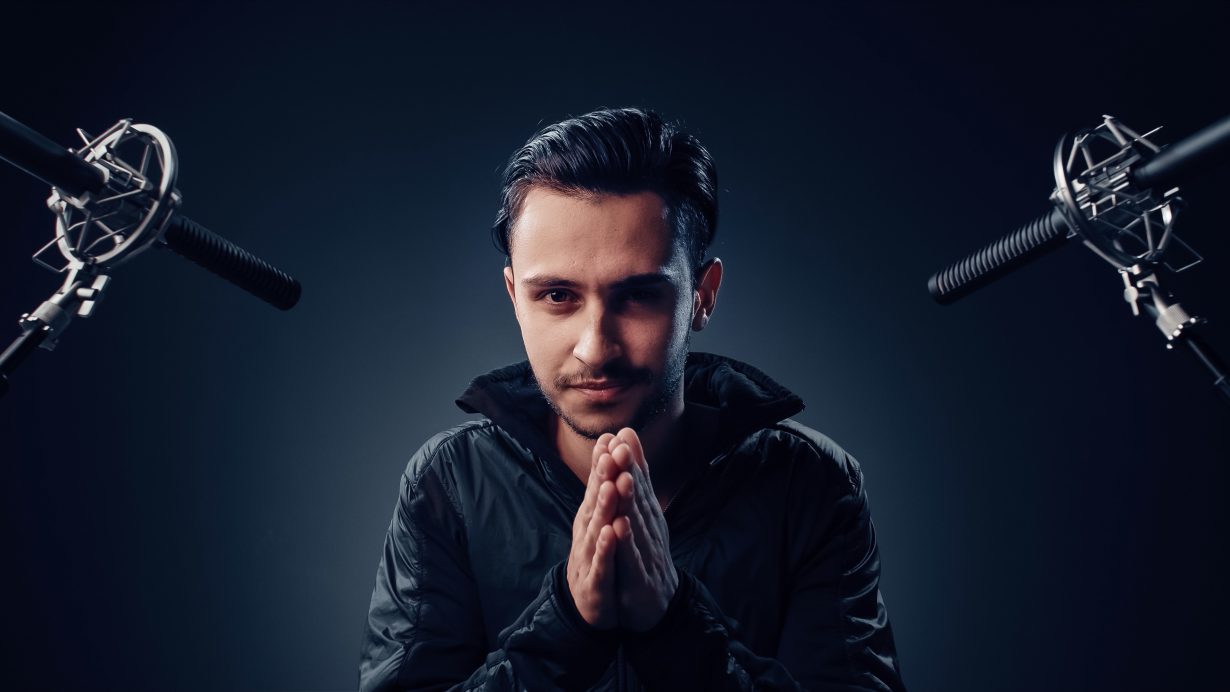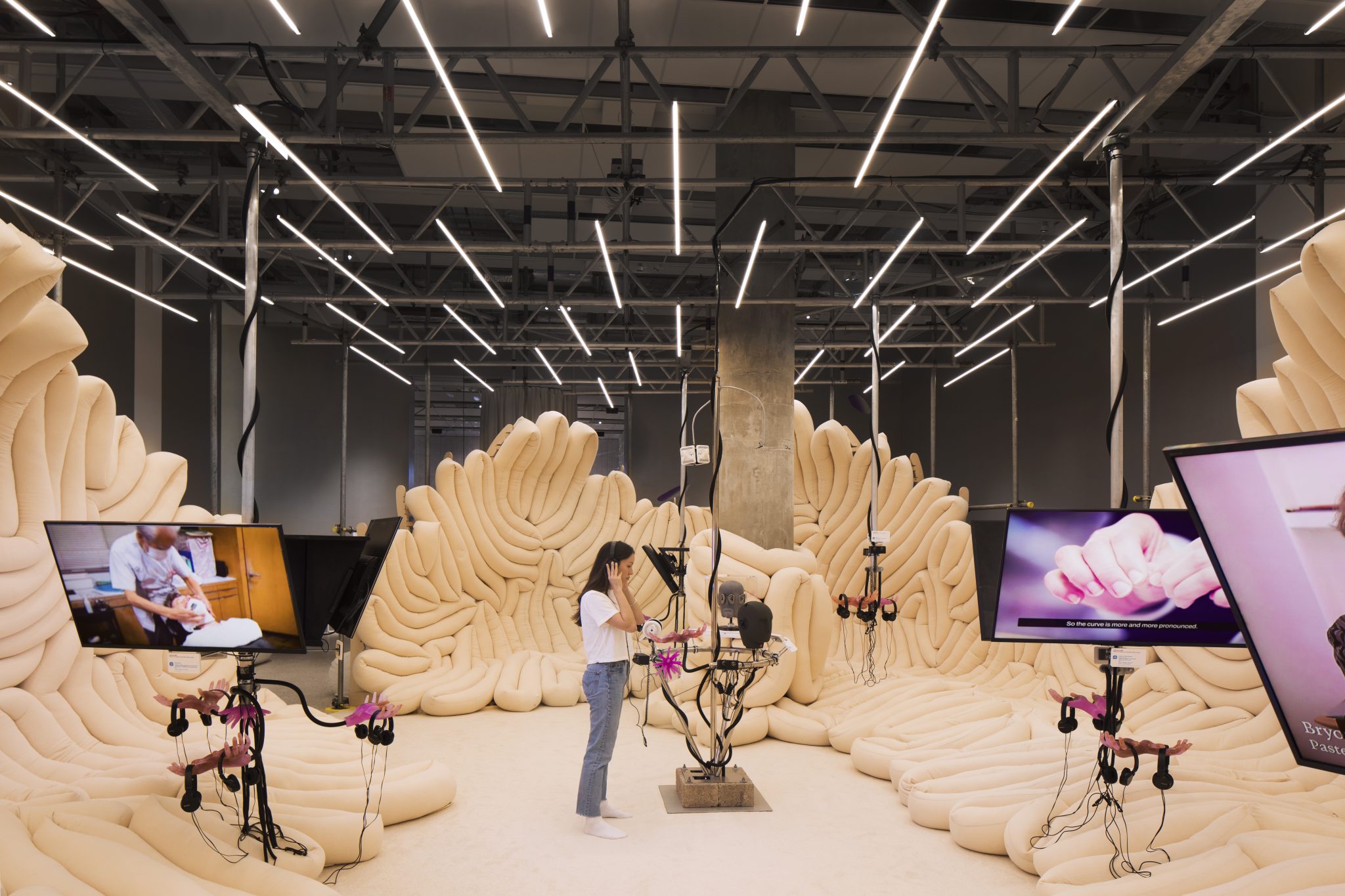A new exhibition at London’s Design Museum makes you feel like a big baby in a room full of other babies (but it’s not necessarily a bad thing)
You’ve probably seen ASMR content, and you probably weren’t looking for it. TikTok and Instagram Reels are now awash with a kind of video that was once fairly niche. A woman in a full face of make-up tickling a high-end microphone with her fingernails, or a close-up of someone dicing soap bars and letting the pieces tinkle onto a table. These strange, meditative pieces of content are supposed to trigger a relaxing feeling in the body, a little-understood brain-tingling sensation only some people can feel that has come to be known as an ‘autonomous sensory meridian response’, or ASMR.
The sensation itself hasn’t been studied much, although one 2018 paper from the University of Sheffield suggested that those who experience the phenomenon had reduced heart rates while watching ASMR videos compared to people who don’t experience it. But their growing popularity over the past decade is inarguable. The main Reddit for ASMR has over a quarter of a million subscribers, and appealing to fans of ASMR has become part of mainstream content production online. Cooking tutorials will often dedicate a section to the particular crunching sound of a dish they make, and caption the content with ASMR related hashtags.
As ‘ASMRtists’ proliferate, creators have had to find ways to innovate: to find new triggers for the sensation and thereby draw more viewers to their content. But is it an artform? A design discipline? WEIRD SENSATION FEELS GOOD: The World of ASMR at London’s Design Museum seeks to address these questions, allowing ASMR videos to escape from people’s bedrooms and phone screens and into a physical exhibition space.
At the start of the exhibition, a sound plays into the room like a marble pinging around a metal basin. On screens, a high-definition pair of cactuses spiral into each other next to wiggling cavolo nero leaves. In another room, you can wear headphones and view Bob Ross videos, listening to the wetness of his mouth, the rapping of his palette knife, the futzing of a paintbrush. Elsewhere, you get to be the ASMRtist, using microphones and everyday objects like nit combs and toothbrushes to produce whatever noises are pleasurable to your ear. The main part of the show is a large enclosure made of long, soft cushions arranged to look like brain matter, where you can sit and watch a range of videos that represent both intentional ASMR content – like a Virgin Atlantic advert with close focus on the fizzing of inflight champagne and the click of a seatbelt – and unintentional ASMR, videos that just happen to tickle the ASMR part of the brain, like one demonstrating how magazines used to be edited using paper and a scalpel.

In France ASMR
By the end of the show, visitors have experienced several different types of ASMR, and ‘experience’ is the word. WEIRD SENSATION is another example of an interesting recent slippage between what is considered an exhibition and what is considered an experience, and where those two events ought to take place. And while you could watch ASMR videos wherever you want, the Design Museum’s curation guides you through videos considered exemplary of the form, lending a feeling of order to the more erratic experience of scrolling an often random-seeming selection online. In some ways, the show feels more like being in a spa than an exhibition. ASMR is about comfort, body over mind, and has a cosy, care-giving element. The most soothing videos are often ones with a visible, and usually female, human component: a woman carefully cutting a dog’s hair, a slow-moving pair of hands stirring through a tub of beads. There is a suggestion of a particular kind of feminine, almost nurturing intimacy, albeit at a digital remove.
Unlike watching ASMR videos in the privacy of your own bedroom, sitting on the squishy brain sofas at the Design Museum as other visitors literally fall asleep around you, it is difficult not to feel like a big baby in a room full of other babies, the museum as creche. But that needn’t necessarily be a bad thing. ASMR is pleasant and not much more than that. The show is the same. WEIRD SENSATION FEELS GOOD, with its knowingly neanderthal grammar, is a fitting title. It feels good to be there, and doesn’t have to prompt deeper thought. ASMR is a medium that encourages you to divorce content from form. Many of the videos in the show are in and of themselves quite boring. But the exhibition invites you to stop thinking about what you’re seeing, and start allowing your body to respond to it: no thoughts, just vibes. ASMR creation may well be a design discipline, but if it is, it’s not one we have to take too seriously.
Obviously, the need to self-soothe with mindless footage of people playing with sand or frying an egg speaks to our hyper-anxious modern age, and the show notes do pose a couple of disquieting questions, if you choose to engage with them. ‘Does ASMR embody a solution to a problem that we do not completely understand? Is it a response to an urgency of which we are not yet fully aware?’ Maybe. But even at the close of the show, as I put a two pence piece in one of those coin spiral vortexes from a 1990s, and listened to it roll and clink its way into the hole, the only thought that crossed my mind was: nice. This feels good.
WEIRD SENSATION FEELS GOOD: The World of ASMR at The Design Museum, London, through 16 October
